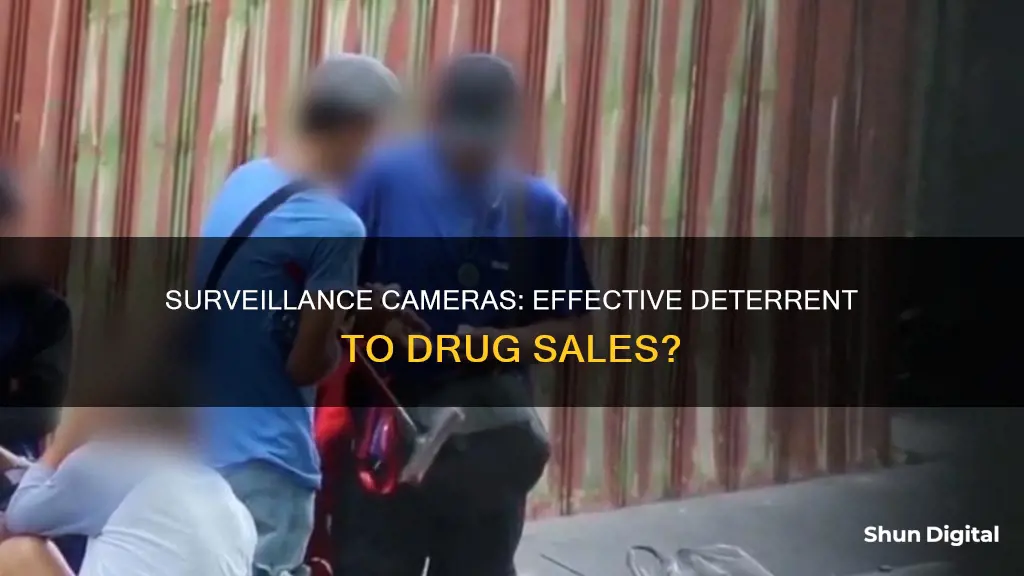
The use of surveillance cameras to deter drug sales is a complex issue that has been the subject of much debate and research. On the one hand, there is evidence to suggest that security cameras can be an effective tool in reducing crime, including drug-related activities. For example, a study by the Municipal Technical Advisory Service found that CCTV cameras are effective in deterring crime when paired with other elements like lighting. The presence of cameras suggests a higher risk of being caught, which may be enough to prevent criminal activity.
However, it is important to note that the effectiveness of security cameras as a deterrent may vary depending on the context and how they are implemented. For instance, a study by Queen's University found that security cameras only deter crime when they function correctly, highlighting 168 technical failures between 2001 and 2003 that prevented evidence from being used in criminal trials. Additionally, the placement of cameras is crucial, as they should be located in high-visibility and high-risk areas to maximize their deterrent effect.
Furthermore, the use of surveillance cameras for drug control raises ethical concerns, particularly regarding privacy. While cameras can capture valuable evidence, they also raise questions about the potential invasion of privacy and the risk of footage being hacked or misused.
In conclusion, while surveillance cameras may have some deterrent effect on drug sales, their effectiveness is not guaranteed and must be weighed against potential drawbacks related to privacy and ethical considerations.
What You'll Learn
- Surveillance cameras are a deterrent, but they are not foolproof.
- The visibility of security cameras enhances their deterrent effect.
- Surveillance cameras are a psychological barrier.
- Surveillance cameras are most effective when paired with other security measures.
- Surveillance cameras can be used to prevent drug use and improve access to drug treatment services.

Surveillance cameras are a deterrent, but they are not foolproof.
Surveillance cameras can deter drug sales, but they are not a foolproof solution. While their presence may reduce criminal activity, it is important to acknowledge that they have limitations and cannot prevent all instances of drug dealing.
The effectiveness of surveillance cameras as a deterrent is supported by several studies. For example, the installation of security cameras in East Orange, New Jersey, led to a 50% decrease in all types of crime. Similarly, the placement of 500 cameras in downtown Baltimore contributed to a significant reduction in crime by an average of 30 incidents per month. These cameras acted as a visible sign of surveillance, increasing the perceived risk of being caught and discouraging criminal activity.
However, it is important to recognize that surveillance cameras are not always successful in deterring drug sales. A study by the Queen's University Surveillance Studies Centre found 168 technical failures in camera systems between 2001 and 2003, preventing the use of evidence in criminal trials. Additionally, the presence of surveillance cameras may be interpreted as an indication of valuables inside, potentially making a location more attractive to thieves.
To enhance the effectiveness of surveillance cameras, it is recommended to pair them with other security measures such as lighting, alarms, and security signs. This multi-layered approach can create a more robust deterrent.
Furthermore, the placement of cameras is crucial. They should be installed in high-visibility and high-risk areas to maximize their deterrent effect. Regular maintenance and monitoring are also essential to ensure the system's effectiveness.
While surveillance cameras can be a powerful tool in deterring drug sales, they should be complemented by other security measures and strategic implementation to create a more comprehensive security strategy.
Fine-Tuning Your Axis M3037: Focus Adjustment Techniques
You may want to see also

The visibility of security cameras enhances their deterrent effect.
The visibility of security cameras is a crucial factor in enhancing their deterrent effect. The presence of security cameras suggests a higher risk of being caught, which often dissuades potential criminals from acting in the first place. This is because criminals do not want to be seen or recorded, and visible cameras make them feel watched.
The placement of cameras in high-visibility and high-risk areas is, therefore, a recommended best practice. In addition, pairing cameras with clear signage indicating surveillance can further reinforce the message that an area is under surveillance. This two-pronged approach can effectively deter potential offenders by increasing their awareness that they are being watched and that their actions will not go unnoticed.
The combination of visible cameras and clear signage creates a powerful psychological barrier, sending a clear message to wrongdoers: "We're watching you, so don't even think about it." This visibility also helps to discourage illegal activities by increasing the perceived risk of detection and capture.
In summary, the visibility of security cameras is a critical component of their deterrent effect, and strategic placement and signage can further enhance this effect, creating a powerful tool to prevent crime before it happens.
Charging Your Canon Camera Battery via USB: How Long?
You may want to see also

Surveillance cameras are a psychological barrier.
Surveillance cameras are a psychological barrier that can deter drug sales by creating a sense of heightened risk for potential offenders. The presence of visible cameras suggests a higher likelihood of being caught, which often prevents crimes before they occur. This perception of increased risk is a powerful deterrent, sending a clear message to wrongdoers: "We're watching you, so don't even think about it."
The psychological impact of surveillance cameras is evident in numerous studies. For example, in East Orange, New Jersey, the installation of security cameras resulted in a 50% decrease across all types of crimes. Similarly, the University of North Carolina at Charlotte surveyed 422 imprisoned burglars and found that 60% of them considered outdoor security cameras an effective deterrent, stating that they would search for alarms or cameras before breaking into a house.
The visibility of cameras is crucial to their deterrent effect. In high-risk areas, cameras should be placed in prominent locations to maximise their visibility and deter potential criminals. Signage that clearly indicates the presence of surveillance further reinforces this message, acting as a nudge for would-be offenders to reconsider their actions.
While surveillance cameras can be highly effective as a psychological barrier, they are not foolproof. Some studies have shown that security cameras do not always deter crime and may even indicate the presence of valuables to potential offenders. Additionally, technical failures, poor lighting, or adverse weather conditions can impact the effectiveness of these systems.
To maximise the psychological barrier created by surveillance cameras, it is essential to ensure proper placement, high-definition footage, clear signage, and regular maintenance.
Best Cameras for Apple ProRes RAW Output
You may want to see also

Surveillance cameras are most effective when paired with other security measures.
The presence of security cameras can deter crime by suggesting a higher risk of being caught. This is often enough to prevent crime before it happens. The cameras serve as a psychological barrier, sending a clear message to wrongdoers that they are being watched.
However, security cameras do not always deter crime. There are cases where security cameras have failed to prevent crimes from happening. For instance, in Lincoln, Nebraska, security cameras placed in a downtown bar street did not help identify criminals or prevent crimes. During the time the cameras were operational, 128 assaults took place within 500 feet.
To maximize the deterrent effect of security cameras, it is important to consider their placement, visibility, and maintenance. Cameras should be installed in high-visibility and high-risk areas, and paired with clear signage to indicate surveillance. Regular maintenance and monitoring are also necessary to keep the system effective.
Additionally, security cameras are most effective when paired with other security measures. A study by the University of North Carolina surveyed 422 burglars and found that half of them considered outdoor security cameras effective deterrents. However, the study also revealed that burglars deemed other measures, such as alarms and security signs, as effective deterrents.
In summary, while security cameras can be a powerful tool in deterring crime, they are even more effective when combined with other security measures such as alarms, lighting, and security signs. By integrating multiple layers of protection, homeowners and businesses can create a comprehensive security system that maximizes deterrence and protects their property.
RAW Files: Camera Limitations and Workarounds
You may want to see also

Surveillance cameras can be used to prevent drug use and improve access to drug treatment services.
Surveillance cameras can be used to prevent drug use and improve access to drug treatment services in several ways. Firstly, they can be utilised as part of public health surveillance systems to monitor and track drug use trends, especially among youth and young adults who are active users of social media. This data can then be used to inform prevention programs and interventions aimed at reducing drug use. Additionally, social media platforms can be leveraged to conduct drug use prevention campaigns and raise awareness about the harms of drug use, particularly targeting young people.
Surveillance cameras can also play a role in improving access to drug treatment services. For example, telemedicine and internet pharmacies that utilise surveillance cameras can enhance access to healthcare and drug treatment services, especially for those with drug use disorders. Online platforms can also be used to share information about the adverse consequences of drug use and communicate warnings about adulterated or counterfeit drugs, which could ultimately save lives. Furthermore, by monitoring online platforms, law enforcement authorities can detect and prevent drug trafficking activities, thereby reducing the availability of drugs on the illicit market.
However, it is important to note that the use of surveillance cameras for drug prevention and treatment should be balanced with privacy concerns and ethical considerations. As technology advances and surveillance methods become more sophisticated, it is crucial to protect the privacy and personal information of individuals, especially when it comes to their health data.
The Wyze Camera Battery: How Long Does It Really Last?
You may want to see also
Frequently asked questions
Surveillance cameras can deter drug sales, but their effectiveness depends on several factors, including placement, visibility, lighting, and whether they function correctly. While some studies show a reduction in crime where cameras are present, others show no significant impact. Overall, cameras can be a useful tool but should be paired with other security measures for maximum effectiveness.
Surveillance cameras deter drug sales by increasing the perceived risk of being caught. The presence of cameras suggests a higher chance of detection, which may be enough to prevent a crime before it happens. Well-placed and visible cameras send a clear message to potential offenders that they are being watched.
Surveillance cameras can help prevent drug sales and other criminal activities in an area. They provide a visible sign of monitoring, which discourages wrongdoers from engaging in illegal activities. Cameras can also aid in gathering evidence and resolving incidents quickly if a crime occurs.
One drawback is the cost of installing and maintaining a surveillance camera system. Additionally, cameras may not always function correctly, and technical failures can prevent them from capturing crucial evidence. Another concern is privacy, as cameras can capture footage of people who are not engaged in criminal activity.







